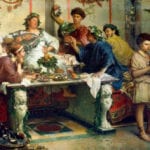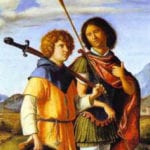 Technology
Technology  Technology
Technology  Humans
Humans 10 Everyday Human Behaviors That Are Actually Survival Instincts
 Animals
Animals 10 Animals That Humiliated and Harmed Historical Leaders
 History
History 10 Most Influential Protests in Modern History
 Creepy
Creepy 10 More Representations of Death from Myth, Legend, and Folktale
 Technology
Technology 10 Scientific Breakthroughs of 2025 That’ll Change Everything
 Our World
Our World 10 Ways Icelandic Culture Makes Other Countries Look Boring
 Misconceptions
Misconceptions 10 Common Misconceptions About the Victorian Era
 Mysteries
Mysteries 10 Strange Unexplained Mysteries of 2025
 Miscellaneous
Miscellaneous 10 of History’s Most Bell-Ringing Finishing Moves
 Technology
Technology Top 10 Everyday Tech Buzzwords That Hide a Darker Past
 Humans
Humans 10 Everyday Human Behaviors That Are Actually Survival Instincts
 Animals
Animals 10 Animals That Humiliated and Harmed Historical Leaders
Who's Behind Listverse?

Jamie Frater
Head Editor
Jamie founded Listverse due to an insatiable desire to share fascinating, obscure, and bizarre facts. He has been a guest speaker on numerous national radio and television stations and is a five time published author.
More About Us History
History 10 Most Influential Protests in Modern History
 Creepy
Creepy 10 More Representations of Death from Myth, Legend, and Folktale
 Technology
Technology 10 Scientific Breakthroughs of 2025 That’ll Change Everything
 Our World
Our World 10 Ways Icelandic Culture Makes Other Countries Look Boring
 Misconceptions
Misconceptions 10 Common Misconceptions About the Victorian Era
 Mysteries
Mysteries 10 Strange Unexplained Mysteries of 2025
 Miscellaneous
Miscellaneous 10 of History’s Most Bell-Ringing Finishing Moves
10 Eyewitness Accounts of History
History is made up of the countless events that take place all around us. Some are mundane and will never be written down, but some shape the course of nations. Many historical accounts are only created centuries after the facts and are built on numerous documents and artifacts. Sometimes, however, people who were actually present record their experiences and impressions of what it was actually like to be alive during history. These eyewitness accounts are invaluable for helping us understand the past.
Here are ten eyewitnesses who had a front-row seat to history.
Related: 10 Unwitting Witnesses to the Assassination of President Kennedy
10 Visit to Caligula
Philo of Alexandria was one of the foremost Jewish philosophers of the 1st century AD. Alexandria in Egypt was a cosmopolitan city where Greeks, Jews, and Egyptians lived side-by-side—not always peacefully. Conflicts between the communities were frequent. That is why, in AD 38, Philo was sent as an ambassador to Rome to help secure the rights of the Jews of Alexandria. His mission was to present a petition to the Emperor Gaius. Gaius is better known to history as the mad Emperor Caligula.
Philo wrote down what happened and became our only source who actually met Caligula. The ambassadors were taken into a garden and presented to the emperor. “The moment that we saw him, bent to the ground with all imaginable respect and adoration, and saluted him calling him the emperor Augustus.” Their obsequiousness did not much help. Caligula said, “You are haters of God, inasmuch as you do not think that I am a god, I who am already confessed to be a god by every other nation, but who am refused that appellation by you.”
While trailing Caligula around the gardens, the Jewish ambassadors try to explain why their God does not permit them to worship him and also why they don’t eat pork. Eventually, Caligula took pity on them, saying, “These men do not appear to me to be wicked so much as unfortunate and foolish, in not believing that I have been endowed with the nature of God.” Philo was dismissed back home, and Caligula carried on believing he was God until AD 41, when he was assassinated.[1]
9 A Gladiator Fight
Gladiators—slaves who fought in public games—were sex symbols in ancient Rome. They still have that reputation today. Instead of the models with the six-packs we might imagine today, they were probably a little chunky as they were fed a diet that gave them a layer of fat. This helped to protect them, and any wounds would bleed impressively for the crowd when they were struck. Gladiator combat remained popular with the mob for centuries, though some refined Romans found it distasteful or boring. Julius Caesar became unpopular for doing paperwork while seated in his box at the games.
The philosopher Seneca left an account of what a day at the games was like in the 1st century AD. It began in the morning when “men are thrown to bears or lions.” In the afternoon came the gladiators on gladiator combats. “The crowd cries for the killers to be paired with those who will kill them and reserves the victor for yet another death. This is the only release the gladiators have. The whole business needs fire and steel to urge men on to fight. There was no escape for them. The slayer was kept fighting until he could be slain.”
Many gladiator fights were not to the death, but it seems when they were, the fighters needed some encouragement to take part. “‘Kill him! Flog him! Burn him alive!’ (the spectators roared) ‘Why is he such a coward? Why won’t he rush on the steel? Why does he fall so meekly? Why won’t he die willingly?’” [2]
8 Dinner with Attila the Hun
In the 4th and 5th centuries, the Huns invaded Europe and inflicted defeats on both the Western and Eastern Roman Empires. Attila was so feared that his enemies called him “The Scourge of God.” In AD 448, Priscus of Panium was sent as an ambassador to meet Attila.
Priscus was invited to dine with Attila in the king’s large house designed for feasts. After lengthy toasts of wine given in a strict order of precedence, a meal was called forth. “A lavish meal, served on silver trenchers, was prepared for us and the other barbarians, but Attila just had some meat on a wooden platter, for this was one aspect of his self-discipline. For instance, gold or silver cups were presented to the other diners, but his own goblet was made of wood. His clothes, too, were simple, and no trouble was taken except to have them clean. The sword that hung by his side, the clasps of his barbarian shoes and the bridle of his horse were all free from gold, precious stones or other valuable decorations affected by the other Scythians.”
After an evening of storytelling and jokes—not to the Roman’s liking, by the way—Priscus departed. “After spending most of the night at the party, we left, having no wish to pursue the drinking any further.” The threat from Attila only ended when he died of a nosebleed on his wedding night some years later.[3]
7 The Athenian Plague
In the second year of the Peloponnesian war between Athens and Sparta, 430 BC, the population of the lands around Athens had been pulled back within the city’s great walls for protection. The overcrowded city became rife with disease, and when a plague broke out, it spread rapidly and disastrously.
The writer Thucydides composed the great history of this war and left an account of the plague, which was made all the more vivid by his having caught the sickness and survived it. He described how it started with a fever but was followed by vomiting that “discharges bile of every kind… accompanied by very great distress.” The fever increased until sufferers could not bear to have any clothes on at all. People hurled themselves into water cisterns to relieve their thirst. Death came in nine days.
Even those who survived might be left scarred for life. “Even where it did not prove mortal, it still left its mark on the extremities; for it settled in the privy parts, the fingers and the toes, and many escaped with the loss of these, some too with that of their eyes. Others again were seized with an entire loss of memory on their first recovery, and did not know either themselves or their friends.”
Thousands died, including the Athenian leader Pericles. The loss of manpower almost certainly handed victory in the war to Sparta.[4]
6 President Lincoln Shot
In 1956, a man was brought on to the game show I’ve Got a Secret. At 96, when it was recorded, it was revealed that Mr. Seymour had been present in Ford’s Theatre in 1865 when President Lincoln was assassinated. Having been just five at the time, all he remembered was being concerned for a man who fell to the stage from a box. That man was the killer: John Wilkes Booth.
In the president’s box that night was Major Henry Rathbone. A year after the killing, he wrote down what happened. “When the second scene of the third act was being performed, and while I was intently observing the proceedings upon the stage, with my back toward the door, I heard the discharge of a pistol behind me, and, looking round, saw through the smoke a man between the door and the President… I instantly sprang toward him and seized him. He wrested himself from my grasp, and made a violent thrust at my breast with a large knife. I parried the blow by striking it up, and received a wound several inches deep in my left arm.”
Booth leaped from the box, injuring his leg, and held his dagger aloft, announcing, “Sic semper tyrannis!”—”Thus ever for tyrants!” Booth and his accomplices escaped but were tracked down to a farmhouse and killed by the forces pursuing them.[5]
5 Queen Elizabeth’s Breasts
The reign of Queen Elizabeth I, 1558–1603, is often looked on as a golden age for England. The Virgin Queen, as she was known, never married and became a symbol of England’s stand against the powers of Europe. Part of her power was in the display of wealth and regality that she presented to the world. Her clothes were so heavily jeweled that it was said they stood up on their own.
In 1597, the French ambassador Andre Hurault-Sieur de Maisse was granted an audience with the 65-year-old monarch, and she managed to make quite the impression. “She was strangely attired in a dress of silver cloth, white and crimson, or silver ‘gauze,’ as they call it. This dress had slashed sleeves lined with red taffeta, and was girt about with other little sleeves that hung down to the ground, which she was for ever twisting and untwisting.” A chain of rubies was hung about her, but there was one thing that most struck Maisse.
“She kept the front of her dress open, and one could see the whole of her bosom, and passing low, and often she would open the front of this robe with her hands as if she was too hot.” [6]
4 The Boston Tea Party
The British colonies in North America—well, at least 13 of them—did not like having to pay taxes to the British government. By giving a monopoly of tea importation to the East India Company, the British ensured that the duties to be paid on it would end up in their coffers without directly taxing the Americans. This still did not sit well with the colonists, who resented even this. In 1773, three ships bearing tea docked in Boston, and a crowd of 7,000 came to protest. George Hewes was among the 200 who raided the ships, some while dressed as Native Americans.
“It was now evening, and I immediately dressed myself in the costume of an Indian, equipped with a small hatchet, which I and my associates denominated the tomahawk, with which, and a club, after having painted my face and hands with coal dust in the shop of a blacksmith, I repaired to Griffin’s wharf, where the ships lay that contained the tea. When I first appeared in the street after being thus disguised, I fell in with many who were dressed, equipped and painted as I was.” They boarded the ships. “We then were ordered by our commander to open the hatches and take out all the chests of tea and throw them overboard, and we immediately proceeded to execute his orders, first cutting and splitting the chests with our tomahawks, so as thoroughly to expose them to the effects of the water.”
To ensure that no tea could be recovered, small boats were launched, and wherever any was spotted floating, they beat it with oars to render it unusable.[7]
3 Execution of a British King
To kill a king is a serious business. Many at the time thought that kings were appointed by God. One person who thought this was Charles I of England. Losing a Civil War against those who supported the power of parliament did not dampen his faith in the Divine Right of Kings. He was put on trial and sentenced to death.
An anonymous account exists of Charles being led out onto a scaffold in the middle of London. There, he delivered a short speech justifying his actions before being directed toward the block where his head was to be cut off. The king said to a bishop present, “I go from a corruptible to an incorruptible crown; where no disturbance can be, no disturbance in the world.” Then, the king stretched out his neck and said some prayers.
“After a very short pause, his Majesty stretching forth his hands, the executioner at one blow severed his head from his body; which, being held up and showed to the people, was with his body put into a coffin covered with black velvet and carried into his lodging. His blood was taken up by divers persons for different ends: by some as trophies of their villainy; by others as relics of a martyr; and in some hath had the same effect, by the blessing of God, which was often found in his sacred touch when living.”[8]
2 Execution of a French King
The French Revolution of 1789 sparked a series of wars that reverberated through the 19th century. King Louis XVI was first taken into the custody of the revolutionaries, but when he proved unwilling to support them, he was deposed from his throne and then sentenced to death. Henry Essex Edgeworth was the Irish priest who acted as Louis’s confessor through his last days and was with the king as he went to the guillotine. He recounts the final moments.
“As soon as the King had left the carriage, three guards surrounded him, and would have taken off his clothes, but he repulsed them with haughtiness- he undressed himself, untied his neckcloth, opened his shirt, and arranged it himself. The guards, whom the determined countenance of the King had for a moment disconcerted, seemed to recover their audacity. They surrounded him again, and would have seized his hands. ‘What are you attempting?’ said the King, drawing back his hands. ‘To bind you,’ answered the wretches. ‘To bind me,’ said the King, with an indignant air. ‘No! I shall never consent to that: do what you have been ordered, but you shall never bind me…’”
The king was led to the guillotine by guards who “seized with violence the most virtuous of Kings, they dragged him under the axe of the guillotine, which with one stroke severed his head from his body. All this passed in a moment. The youngest of the guards, who seemed about eighteen, immediately seized the head, and showed it to the people as he walked round the scaffold; he accompanied this monstrous ceremony with the most atrocious and indecent gestures.” [9]
1 A Viking Funeral
Ahmad ibn Fadlan was an Islamic traveler in the 10th century who visited many places and acted as a religious guide. In 921, he joined a group traveling in what is now Russia to explain Islamic law to the local people. He has left one of the only accounts of a Norse funeral written by an eyewitness.
“When that man whom I mentioned earlier died, they said to his slave-girls, ‘Who will die with him?’ and one of them said, ‘I shall.’ So they placed two slave-girls in charge of her to take care of her and accompany her wherever she went, even to the point of occasionally washing her feet with their own hands. They set about attending to the dead man, preparing his clothes for him and setting right all he needed. Every day the slave-girl would drink and would sing merrily and cheerfully.
“On the day when he and the slave-girl were to be burned I arrived at the river where his ship was. Then the ship was hauled and placed on top of this wood.
“Then they produced a couch and placed it on the ship, covering it with quilts Byzantine silk brocade and cushions Byzantine silk brocade. Then a crone arrived whom they called the ‘Angel of Death’ and she spread on the couch the coverings we have mentioned. She is responsible for having his sewn up and putting him in order and it is she who kills the slave-girls. I myself saw her: a gloomy, corpulent woman, neither young nor old.”
The slave girl to be sacrificed then had sex with all the men present and was stabbed to death by the “angel of death” and placed beside her master. The ship was then set ablaze.[10]








